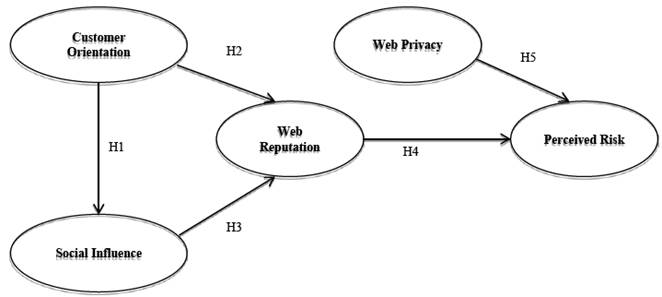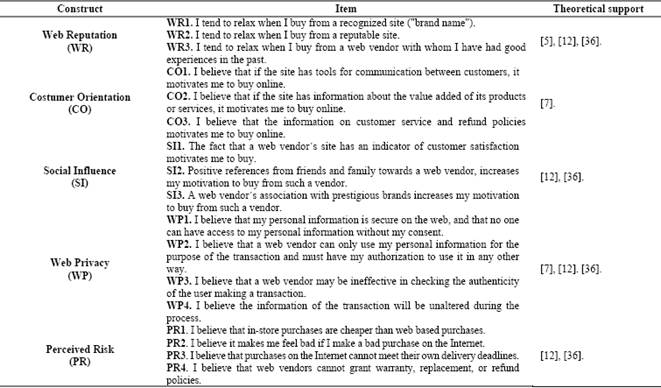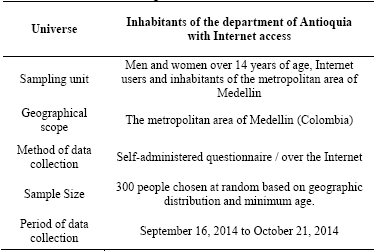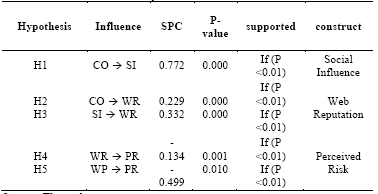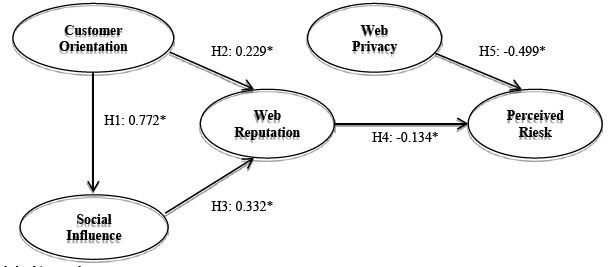1. Introduction
The study of consumer behavior is based on Social Cognitive Theory (SCT) from the field of behavioral psychology. This is a behavioral model based on the influence of personal and environmental factors, and the behavior of the individual expressed in the concept of self-efficacy [1]. Its most frequently applied theory is the Technology Adoption Model (TAM) which predicts whether buyer behavior with respect to the intention and use of the electronic purchase is generated based on individual attitude affected by perceived usefulness and perceived ease of use [2].
New factors influencing purchasing behavior have been grouped by Venkatesh & Xin-Thong [3] under the Unified Theory of Acceptance and Use of Technology (UTAUT2). Likewise, research has moved up a step, now analyzing the e-consumers and their actions in terms of web use, their interactions with businesses and society, and the impact of online purchasing on consumer satisfaction and therefore loyalty. Some studies have focused on analyzing these issues from the perspective of evaluating the web vendor using quality scales [2], "ES-QUAL" [4]. Thus incorporating a basic and decisive factor, perceived trust [1,5-7], which is contrary to the perceived risk factor, defined as the potential negative consequences of online shopping [8].
Social influence, originating within the concept of subjective norm, emerges in the same line and relates the influence of social factors and image on the buying process [5]. The relationship between social factors and trust in online shopping has recently been demonstrated [9].
This study focuses on how social factors and the ability of the web vendor in customer orientation, directly influence the reduction of perceived risk, and thus increase trust. The study is conducted in the metropolitan area of Medellin (composed of 10 municipalities), one of Colombia’s most important cities. Previous studies conducted in Colombia demonstrate a high degree of perceived risk when buying online, as well as the importance buyers place on factors of trust, such as privacy and e-commerce security [6,10,11].
The objectives of this research were a) to determine whether social factors affect risk perception in online purchasing, based on its direct influence on reputation and as part of the indirect effect in reducing customers’ perception of risk. We also validate whether or not web privacy maintains its strong influence when evaluated only with reputation, isolated from other factors of trust.
The work is structured as follows: initially a model is proposed from a literature review. Then, the empirical study is designed and applied in the metropolitan area of Medellin, Colombia. The data collected is then statistically processed and the relationship and impact of variables is analyzed. Finally, conclusions are presented and future work is suggested.
2. Literature review and model proposal
2.1. Perceived risk
Buying decisions carry some level of risk in terms of the uncertain environment faced by the buyer, and the possible negative consequences of the buying process. Even after the online purchase has been made, the buyer will not know whether or not the chosen product or vendor will actually satisfy his/her needs. Buyers will thus attempt to mitigate this perceived risk by assessing different alternatives and selecting the one with the lowest perceived risk [12-14].
It has been found that perceived risk is a major obstacle for buyers considering making an online purchase; an obstacle that is substantially greater than those possibly experienced in physical stores. It is not surprising that consumers will be more reluctant to make online transactions, given the potential losses that may result from the decisions made in uncertain environments [12,14,15].
In traditional stores, buyers can touch, feel, and even try the product before deciding to buy it; this immediately reduces the perceived risk, and probably reinforces positive reviews from consumers about the store. In online purchasing, on the other hand, not only can the buyer not try the product, but s/he also has to provide valuable personal information such as home address, phone number, and even credit card information, and then wait for the transaction to be approved [12-15].
2.2. Customer orientation
To understand the concept of customer orientation, we first have to understand what Market Orientation (MO) is. MO is the ability of organizations to interact with their environment, allowing them to anticipate market needs and create long-term relationships with their customers, suppliers, and distribution channels [16].
Market orientation makes companies more capable of reaching their objectives; however, for its implementation to be successful, significant cultural transformation is required to develop the values and standards of conduct related to this management approach. MO can be considered a construct consisting of three behavioral components of equal importance: customer orientation, competition orientation, and functional coordination, with two decisional criteria: long-term focus and profit orientation [16].
As such, customer orientation can be defined as a company’s knowledge of its target market in order to be able to create superior value for such a niche. This knowledge enables the organization to explore opportunities for innovation and reduce the potential risks of confusing the buyers’ needs. It calls for a continuous and proactive willingness to meet customer demands [17,18], but could also be used as a tool to influence customers and somehow increase the reputation of the organization. According to the above, it is proposed that the following relations should be verified:
H1: The online vendor´s customer orientation affects social influence
H2: The online vendor´s customer orientation affects the perceived reputation of such vendors.
2.3. Social influence
The concept of social influence is based on the subjective norm proposed in the Technology Adoption Model (TAM), and describes the influence of people who are important to the subject making decisions, even if these other views go against the buyer’s own views in terms of the purchase [19]. This concept has therefore been linked directly with online buying, adding social factors to it [20], [21]. Hence its importance lies in the effect of influential people’s favorable or unfavorable opinions about the web vendor. It can therefore be considered that social influence can directly influence a vendor´s reputation. This study intends to verify the following relationship:
H3: The social influence regarding a web vendor positively influences its perceived reputation.
2.4. Web reputation
Reputation is what is generally said or believed about the nature or status of a person or thing. Reputation might somehow mitigate the fears that still surround the Internet as a means of doing business. An organization with a good reputation will beget a more positive attitude towards its e-service offer from its customers, as online buyers will favor sellers already known through traditional channels [14,22-25].
Decisions regarding the reputation of an online provider can be a consequence of accumulated experience with such a provider or they can derive from more emotional bases. As such, a buyer will always prefer an online provider with whom a satisfactory transaction has already been experienced. This suggests that satisfaction in past interactions contributes directly to building reputation and increases each time buyers’ expectations are met or exceeded [14,24,26].
2.4.1. The relationship between web reputation and perceived risk
Previous studies support the direct influence between reputation and purchase intention [27], as well as the perceived value of use [28], and an important predictor of trust [29]. These relations generate direct effects on risk perception because reputation is the indicator that assesses the information the buyer has obtained intrinsically from its interaction with the web vendor and extrinsically by social information that influences and therefore directly affects the perception of risk in online buying [30]. The study also aims to verify that:
H4: Perceived reputation of the web vendor directly influences perceived risk in e-commerce.
2.5. Web privacy
Web privacy can be understood as consumers’ concerns about the misuse of the data provided to complete a transaction for other purposes, such as: procurement and inadequate storage of information; distribution to third parties without authorization; invasion of privacy, emailing without prior request, among others. If customers do not perceive that their personal information will be kept private, the purchase will not take place, making this factor an essential part of the decision of whether or not to make an online [13,14,24,31,32].
2.5.1. Relationship between web privacy and perceived risk
Establishing security protocols by businesses and making them visible to consumers can play a major role in reducing perceived risk. Such protocols have to be present both in information gathering and its subsequent use, thereby reducing fear and increasing confidence, so that users are more willing to provide the required personal information [31,33].
Therefore, we propose to verify the following relationship:
H5: Web privacy negatively influences perceived risk.
Finally, having described each of the constructs, and after having established the relations to be verified in the present study, the proposed model is presented (see Fig. 1).
3. Methodology
3.1 Measurement constructs
The five-position Likert scale, a previously validated measuring mechanism [34], was chosen for this study and a pilot test with 31 respondents was conducted to verify the tool’s performance. A number of necessary adjustments were identified and implemented, finally allowing the verification of content validity (Table 1).
The questionnaire was divided into two parts: first, a survey was conducted to profile the sample. Information on gender, age range, level of income, educational level, profession, and place and frequency of Internet access was gathered. The second part asked about each of the variables to be analyzed. This section was built with test questions measured with a 1-5 point Likert scale ranging from "Strongly disagree" to "Strongly agree"; this being the most suitable tool for measuring variables that are not directly measurable or observable [35].
3.2. Sample and fieldwork
The information necessary to conduct this study was collected through an online questionnaire, given that this instrument allows for faster response, it reduces the costs of shipping and receiving the surveys, and it enables easy communication and the elimination of intermediaries [12]. Because an online shopper must be an Internet user to start with, the survey was shared via email and through social networks [36]. It was envisaged that the people invited to participate in the study were residents of metropolitan area of Medellin (Colombia) and over 14 years of age (target population).
The survey was carried out from September 16 to October 21, 2014 achieving a sample size of 300 forms, 20 of which contained discrepancies. Therefore, only 280 questionnaires were valid, making it a sample fitting the objective universe (Table 2).
4. Data analysis and results
A regression analysis of latent variables based on the optimization technique Partial Least Squares (PLS) was used in this study to develop the model that represents the relationships between the proposed constructs measured by the items. This method was chosen because it is an appropriate multivariate technique to structurally test a model [37]. The Smart-PLS software was chosen because it is recommended for small samples [38].
4.1. Exploratory analysis model
The simple reliability of the measurement scales used was calculated by considering the Cronbach's Alpha values. All values above 0.70, the minimum acceptable value according to Nunnually & Bernstein [39], are shown in Table 3. The Table also shows that when applying a more accurate composite reliability analysis, the results were far superior to the 0.65 lower limit value proposed by [40].
Table 3 Cronbach´s Alpha coefficients, Construct Reliability and Analysis of Variance Extracted (AVE).
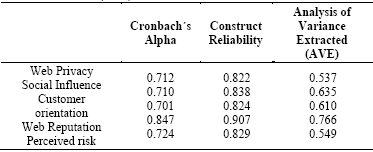
Source: The authors
To assess the convergent validity of the constructs, the statistical AVE (Table 3) was calculated, obtaining that all values are higher than 0.5. It was therefore verified that the items in the scales converge towards a single construct [41]. Regarding discriminant validity, the study analyzed that the correlation between the squared variables (AVE) was superior to the correlation between the constructs [42]. (see Table 4).
4.2. Structural model analysis
In order to test the predictive ability of the model a bootstrapping was performed with an N=500 subsample. From these subsamples, and based on the 0.05 significance level, all P values proved to be significant because they were under 0.05. Thus, all variables are significant and the construct is valid [43] as shown in Table 5.
Finally, with a confidence level of 95%, H1, H2, H3, H4, and H5 are significant because the P values are under 0.05 [43], as seen in Table 6.
The results show that all the hypotheses were validated as a whole (Table 6). First, a web vendor´s market orientation directly affects the social influence. This confirms the importance for a web vendor to interact with all its stakeholders online, and how this interaction will affect the actions of these groups towards such a vendor, affecting its reputation [30].
It was also verified, although to a lesser extent, that the web vendor´s customer orientation influences reputation, confirming that such strategies can enhance the vendor´s reputation [24].
Second, the relationship between a web vendor´s reputation and the risk was validated as being negative; i.e., the higher the positive reputation, the lower the perceived risk, confirming the direct relationship that other studies have shown between reputation and perceived risk [29].
Finally, it is noted that web privacy has a very important effect on reducing perceived risk. Again, an inverse relationship is presented in that as web vendors increase their privacy in terms of customer data, information management, and purchase privacy, a reduction in risk perception is obtained [7].
5. Conclusions
The importance of assessing the influence of social relations in online shopping is based on the integration provided by the Internet for people to interact and communicate quickly. This dynamic creates an environment of constant information exchanges that becomes the most important marketing factor for e-commerce. It has been shown that the actions undertaken by web vendors to address their public, such as open communication spaces (customer forums, social networks), or closed communication spaces (direct communication with the customer, mailing, online customer service) can improve their online reputation and reduce their perceived risk. Likewise, these actions generate an effect on socially influential groups to positively influence the vendors´ online market segment.
Similarly, the importance of the web vendors’ proper management of confidential customer information is a very important risk-reducing factor. Privacy is crucial in trust building. It has been proven that customers highly value the web vendors´ proper information management policies. Therefore, companies should provide information and customer support in relation to the personal data provided in all transactions.
6. Implications for future research
This study presented major limitations in that it only examines the acceptance of perceived risk, which does not allow us to determine whether social factors or customer orientation are determinants of the decision to purchase online. It only assumes improving trust in e-commerce. Moreover, the study was conducted in a country with a short e-commerce history, and further studies should be conducted in countries with a mature e-commerce, such as the United States or some European and Asian countries.
It should be noted that in a country like Colombia, the numerous cases of wire fraud generated by cultural factors increase customers’ risk perception regarding the use of their confidential information online. This is significantly different in other countries [6].
Finally, it is proposed to continue with these research lines and to evaluate cyberspace as a whole, examining how the relationships between actors affect the online purchasing process.













